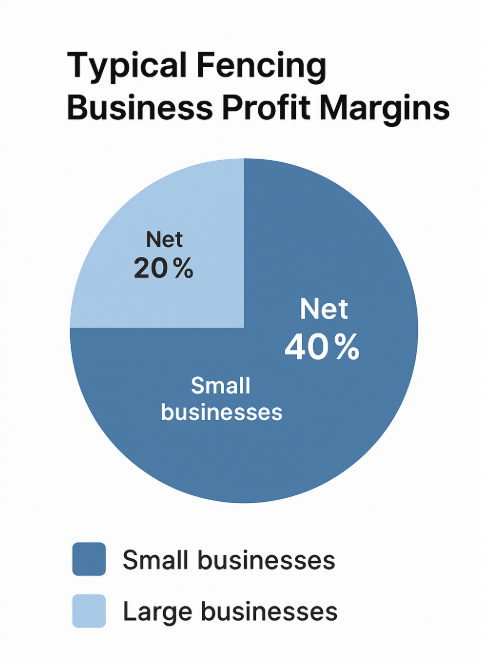Fencing business profit—how much can you actually make, and how do you grow it? That’s the first thing most new fencing business owners want to know. Whether you’re just starting out or already running jobs, understanding your potential fencing business income and how to maximise profit margins is essential.
The good news? Fencing can be highly profitable with the right pricing, efficient project management, and smart material sourcing. But like any trade, margins can shrink quickly if you don’t manage labour, waste, or quoting carefully.
In this guide, we’ll cover the typical profit margins you can expect, the factors that influence profitability, and proven strategies to increase your bottom line. We’ll also walk through a real-world profit breakdown so you can benchmark your numbers against industry averages.
Let’s dive in and make sure your fencing business isn’t just busy—but profitable.
What’s the typical profit margin for a fencing business?
Fencing business profit margins can vary widely depending on the type of projects, the size of your business, and how efficiently you manage costs.
Here’s what most small-to-medium fencing businesses can expect:
- Gross profit margins: Typically 35% to 50%.
- Net profit margins: Usually between 10% and 25% after overheads.
These figures align broadly with construction industry profit margins reported by Stats NZ, although actual results will vary based on market and management.
Several factors influence these margins:
- Materials pricing volatility
- Labour efficiency
- Project size and complexity
- Location (urban vs rural markets)
If you work in subdivision areas or do large fencing jobs for new developments, margins can often be higher due to scale and repeat work (see more about subdivision opportunities).

Key factors that influence fencing business income
To maximise fencing business income, it’s critical to understand what drives both revenue and profit.
Main factors affecting profitability:
- Pricing and market demand in your region.
- Labour management—reducing idle time and improving efficiency.
- Material sourcing and bulk buying for discounts.
- Overhead costs like insurance, marketing, and vehicle expenses.
- Offering additional services (e.g., retaining walls, custom gates).
For small businesses and sole traders, correctly managing tax registration and setup can also improve profitability. If you’re just starting, this guide on how to register as a sole trader can help streamline your business setup.
How to increase fencing business profit?
If your fencing business is busy but margins feel tight, here are proven strategies to grow profit:
- Optimise pricing strategies. Avoid pricing too low just to win jobs.
- Upsell premium materials or designs. Clients often pay extra for durability or aesthetics.
- Improve project scheduling. Minimise downtime between jobs.
- Negotiate better supplier deals. Loyalty and volume can secure discounts.
- Reduce waste. Careful planning can cut material and labour waste significantly.
- Offer specialised services. Decorative fencing, noise barriers, and commercial security fencing often command higher margins.
For those using vehicles extensively, reviewing your mileage rate and charge-out rates can also protect or boost profits.
Managing startup costs and ongoing expenses
Understanding and controlling costs is key to protecting your fencing business profit.
Typical startup costs:
- Tools and equipment (post hole diggers, augers, trucks)
- Licensing and insurance
- Marketing and website setup
- Initial material stock
Ongoing expenses:
- Labour and subcontractor payments
- Fuel and vehicle maintenance
- Supplier invoices
- Marketing and admin overheads
IMAGE: Table listing common startup and monthly operating expenses.
Real example: fencing business profit breakdown
Here’s a simplified profit scenario for a typical fencing job:
| Revenue Item | Amount | Cost Item | Amount |
|---|---|---|---|
| Project Revenue | $15,000 | Materials | $5,000 |
| Labour | $4,000 | ||
| Marketing & Overheads | $2,000 | ||
| Net Profit | $4,000 |
In this case, the job achieves a net profit margin of around 26%—a healthy result for the industry.

Bonus: Smart pricing strategies for fencing businesses
Setting the right prices is critical not just for winning work but also for making that work profitable.
Pricing tips:
- Use value-based pricing where possible—especially for premium or custom work.
- Avoid underpricing to compete solely on cost.
- Calculate all overheads before quoting.
- Review your mileage rate and labour markups regularly.
- Don’t forget to account for future costs like equipment replacement and business growth.
Conclusion
Fencing businesses can be highly profitable when pricing, project management, and cost controls are done right. While typical net profit margins range between 10% and 25%, higher returns are achievable with smart pricing, upselling premium services, and efficient operations.
If you’re just starting out, focus on controlling costs and building a reputation for quality and reliability. As you grow, revisiting your pricing strategy, labour efficiency, and supplier relationships can help you push your fencing business profit even higher.
FAQ about fencing business profit
What is the average profit margin for a fencing business?
Most fencing businesses earn a net profit margin between 10% and 25%, though highly efficient or specialised businesses can achieve more.
How much does a fencing business owner earn annually?
Typical earnings range from $50,000 to $150,000+, depending on project volume, pricing strategy, and overheads.
What’s the best way to improve fencing business profits?
Focus on pricing strategy, upselling premium materials, improving project flow, and cutting unnecessary expenses.
Are fencing businesses profitable in rural areas?
Yes—especially when working on subdivision projects, lifestyle blocks, and large property contracts.
Disclaimer
This article is for information only—not legal, financial, or tax advice. Every business is different, and rules change, so don’t make major decisions based on what you read here. If you’re unsure, talk to a professional—it’s cheaper than fixing a costly mistake later.
